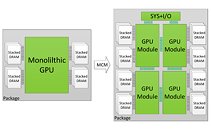Tuesday, October 10th 2017

AMD "Navi" GPU by Q3-2018: Report
AMD is reportedly accelerating launch of its first GPU architecture built on the 7 nanometer process, codenamed "Navi." Graphics cards based on the first implementation of "Navi" could launch as early as by Q3-2018 (between July and September). Besides IPC increments with its core number-crunching machinery, "Navi" will introduce a slew of memory and GPU virtualization technologies.
AMD will take its multi-chip module (MCM) approach of building high-performance GPUs a step further, by placing multiple GPU dies with their HBM stacks on a single package. The company could leverage its InfinityFabric as a high-bandwidth interconnect between the GPU dies (dubbed "GPU module"), with an I/O controller die interfacing the MCM with the host machine. With multi-GPU on the decline for games, it remains to be seen how those multiple GPU modules are visible to the operating system. In the run up to "Navi," AMD could give its current "Vega" architecture a refresh on a refined 14 nm+ process, to increase clock speeds.
Source:
TweakTown
AMD will take its multi-chip module (MCM) approach of building high-performance GPUs a step further, by placing multiple GPU dies with their HBM stacks on a single package. The company could leverage its InfinityFabric as a high-bandwidth interconnect between the GPU dies (dubbed "GPU module"), with an I/O controller die interfacing the MCM with the host machine. With multi-GPU on the decline for games, it remains to be seen how those multiple GPU modules are visible to the operating system. In the run up to "Navi," AMD could give its current "Vega" architecture a refresh on a refined 14 nm+ process, to increase clock speeds.

74 Comments on AMD "Navi" GPU by Q3-2018: Report
btw this is a nvidia slide ;)
AMD did have a wide frame time to guess at all this.
Also, how can infinity fabric fall short when it's already very well proven in Ryzen? Everyone already knows it's good shit.
Why do you think there are no shortages of Ryzen CPU's? It's because they are "glued" together using smaller cores that are cheaper, easier to make and with excellent yields. They have experience with Infinity Fabric already on Ryzen, so if they say Navi comes in Q3 2018, I find that perfectly reasonable timeframe. Hopefully, HBM2 shortages will be fixed by then as well. And this is where HBM2 will come into play. Surface area. For Navi cores, they'll need larger surface for the GPU itself. Which is in a way also a benefit. It's easier to cool larger surface area of GPU than one tiny super hot core. Which is why I think Navi is a great idea if they can make it function.
If the cores will be accessible as indipendent CUs, those cards will be immediately loaded on a 747 parked in the lot outside the fab.
Nothing new really.
Children want a bragging right. A name. Like a $1000 iPhone even tho they will only use it for social media and taking selfies, which can be done equally well on a $200 android phone.
I just think main problem will still be down to HBM2 availability which is still a turd. But now they'll need HBM2 more than ever, because they'll need larger GPU surface area and they can gain that with HBM2 easily. Second problem here along with availability, HBM2 will be the new hot spot, so now that I think about it, this might be a problem for coolers...
Nephew being laughed at. He jumps to it being AMDs fault and asks questions. Never mind that he was the one who offered to build him a AMD system in the first place putting his nephew in this situation.
I'd teach him not to give in to peer pressure and not cave in to children making fun of him.
"I know, it puzzles me why all Ryzen CPUs are being heavily discounted at retail "
?? Define heavily discounted. Or perhaps I should show you a list of Intel CPU prices drops recently to show you the meaning of heavily discounted. I can guarantee that Intel's processors have been discounted much more.
HBM is not on the GPU die for one, and my point really is that VEGA 64 has 4k CUs while the 1080 which it competes with has only 2.5k.
I'm well aware of all that. The fact remains, HBM2 availability is garbage at the moment. It wasn't Vega core that was not available, it was the HBM2 that set back the Vega launch. It has somewhat stabilized now, although Vega isn't exactly a selling hit anymore which explains why availability has stabilized now. Or they solved the availability. One or another. Or mix of both...